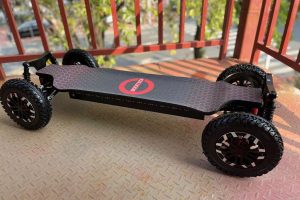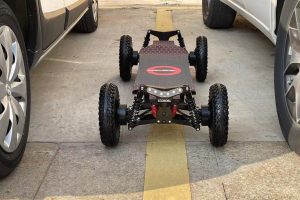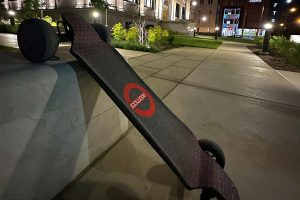Electric skateboards provide a thrilling way to commute, with wireless control over speed and braking. But mastering emergency braking is crucial for safety when unexpected obstacles arise. This comprehensive guide covers everything you need to know about braking system basics, techniques for various situations, tips for staying safe, and how to practice braking confidence.

Understanding Electric Skateboards
Electric skateboards run on a rechargeable lithium battery powering either a hub motor inside the wheels or a belt-driven motor under the deck. A handheld wireless remote connects to a control board that detects your movements. Tilting the remote forward accelerates the motor while tilting back engages the electronic brakes.
Various sensors and gyroscopes help determine speed, direction, and stability. When braking, regenerative systems first slow the motor, generating some energy back to the battery. Friction brakes then clamp down on the wheels to bring you to a complete stop. The quality of these electronic components impacts overall braking responsiveness and power.
The Basics of Emergency Braking
Proper emergency braking technique is essential for safety when you need to stop immediately. Follow these steps:
- Stay centered over the board, knees bent, for stability. Keep your head up and your body lowered.
- Avoid braking only with your heels or toes, which can cause you to fly off. Apply even pressure across the whole foot.
- Lean back slightly to put more weight on the rear brakes. Distribute weight evenly between both feet.
- Press back on the remote smoothly but quickly to brake firmly yet controlled.
- Keep arms out at your sides for balance, prepared for sudden deceleration.
- Look ahead of you, not down at the board, to identify obstacles.
- Consider jumping off at very high speeds if brakes are unresponsive. Roll or slide to shed momentum.
Avoid slamming the brakes at full force all at once. Brake hard but evenly without locking the wheels. Gradual braking may be necessary at extreme speeds. Practice the technique at slow speeds first.

Techniques for Different Situations
The best emergency braking technique depends on the riding situation:
- Downhill – Brake gradually and intermittently to control speed. Heel braking can help shed speed but avoid sudden front braking.
- Wet Conditions – Begin braking sooner and more gently, providing additional distance for stopping. Lean back over the rear truck to remain stable if the wheels slide.
- Crowded Areas – Apply fast, steady braking while shouting a warning to pedestrians. Search ahead for gaps to steer towards.
- Potholes/Cracks – Release the throttle and avoid slamming on the brakes to prevent catching in cracks. Momentum may carry you through.
- Night Riding – Allow extra reaction time to identify obstacles. Use lights and reflectors to remain visible to others while braking.
- Sand/Gravel – Brake gradually to avoid losing traction. Bend knees and absorb shock if wheels lock and slide.
Practicing Emergency Braking
Before riding in public, practice emergency braking techniques in empty parking lots and courses. Start at slow speeds and work up gradually. Wear full safety gear during practice sessions.
Begin braking at different speeds to understand stopping distances. Test braking uphill, downhill, and on slopes to learn weight distribution techniques. Practice targeting cones or markers to learn to steer while braking quickly.
Start on the smooth pavement to learn proper form before trying rougher terrain. Enlist spotters to provide feedback and protect you while learning. Mastering emergency braking takes time, patience, and regular practice. Don’t rush the learning process.
Safety Equipment & Braking Tools
Always wear a helmet and slide gloves while riding. Elbow, knee, and wrist guards also help prevent injury in a fall. Avoid loose clothing that could catch on wheels.
Some electric skateboards come equipped with brighter headlights and brake lights to aid visibility. Swapping to higher grip tape can allow better footing when braking suddenly.
Look for boards with regenerative brakes that recapture energy, as well as reverse capability to brake using the motor. Disc brakes provide more consistent, high-powered braking across different terrains.

Safety Tips
- Check battery charge before riding. Low power can affect brake responsiveness.
- Test brakes at low speeds each time you ride. Ensure they are functioning properly.
- Slow down and brake earlier when riding at night or in crowds.
- Maintain a safe distance from other riders, vehicles, and pedestrians.
- Keep wheels in quality condition and have brakes serviced regularly.
- When in doubt, wear safety gear and take a defensive riding approach.
Assisting with Braking
Electric skateboards continue rolling briefly after throttle release. Use these techniques to help slow down gradually:
- Lightly drag your foot – Slightly scraping your front foot helps shed some momentum. Keep pressure light to stay in control.
- Carving – Making wide S-turns brings speed down and remains stable.
- Body posture – Lowering your stance and leaning back shifts weight to assist with braking.
- Avoid obstacles – Scan ahead and avoid bumps that could disrupt braking.
- Use inclines – Letting gravity assist with braking on hills or ramps.
Conclusion
Learning to brake suddenly yet safely on an electric skateboard takes regular practice and commitment to safety. But mastering emergency braking is necessary to save you from accidents. Prioritize control over speed.
Brake intelligently, brake strategically, and brake safely. With the techniques, tips, and practice outlined in this guide, you can become confident and effective when braking on your electric skateboard.
Read More
- Electric Skateboarding 101 Mastering The Ride – Ecomobl
- Electric Skateboard Tips Rough Terrain – Ecomobl
- Optimal Wheel Size Electric Skateboard – Ecomobl
- Review Of The Best Electric Mountain Skateboard Ecomobl Ripper – Ecomobl
- Understanding The Different Types Of Electric Skateboards – Ecomobl




